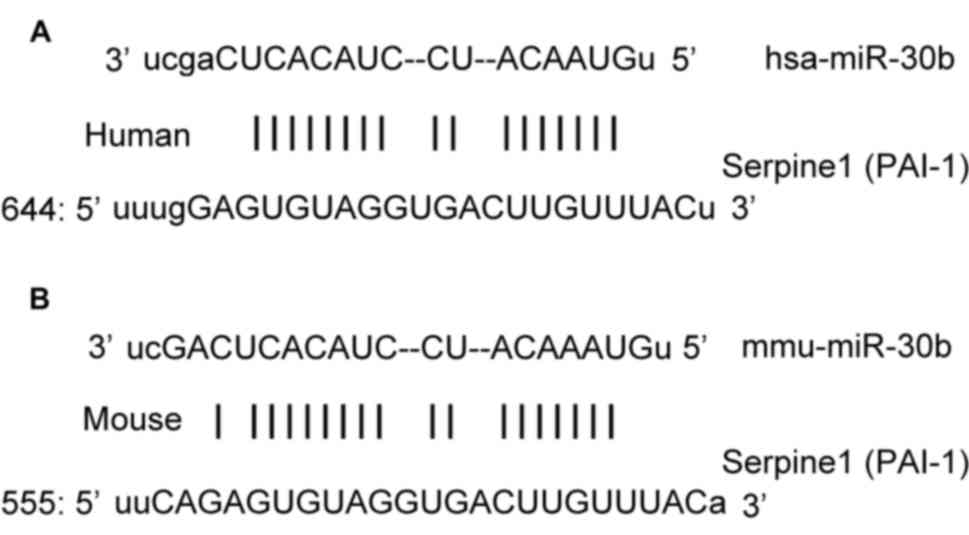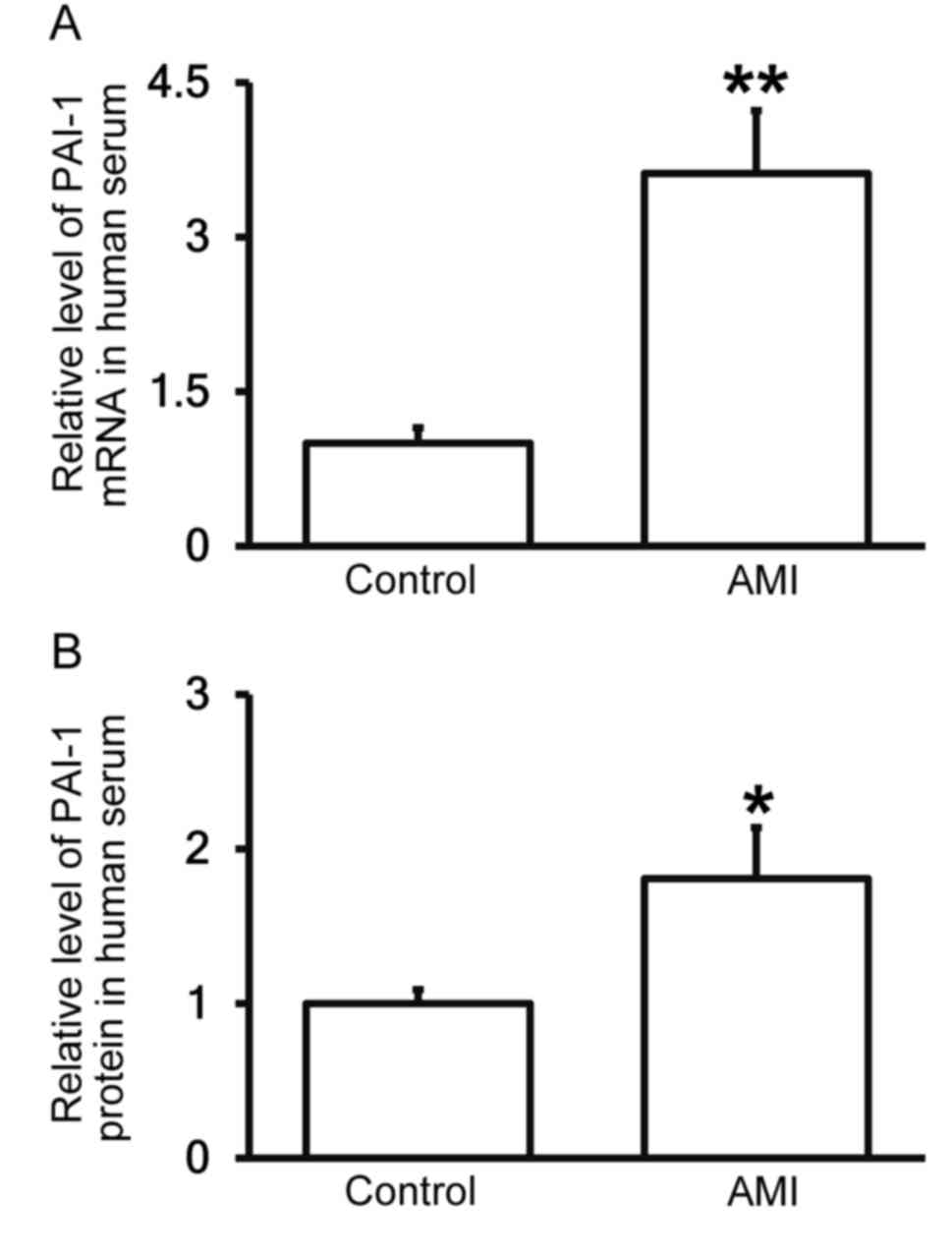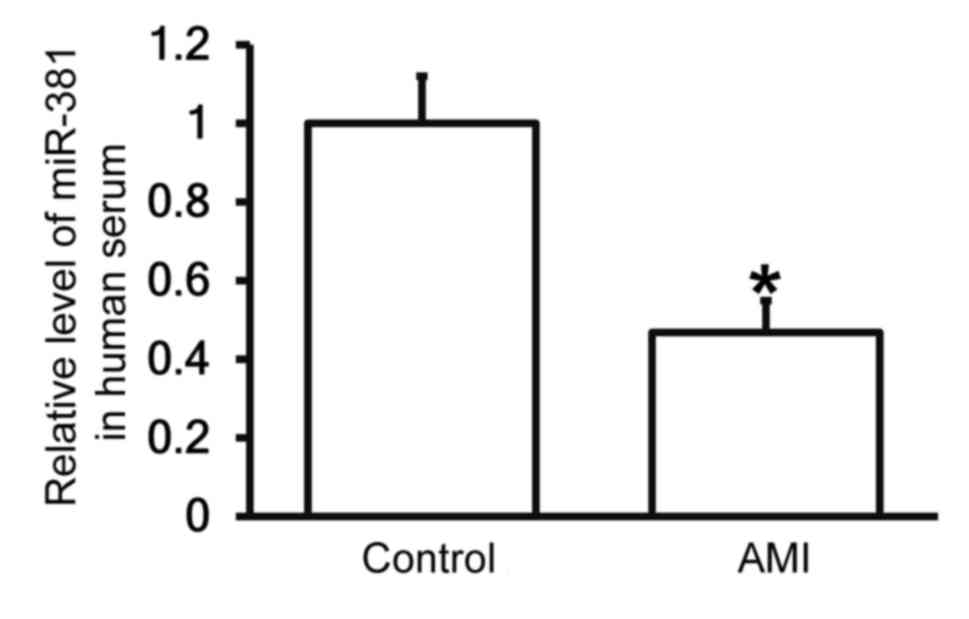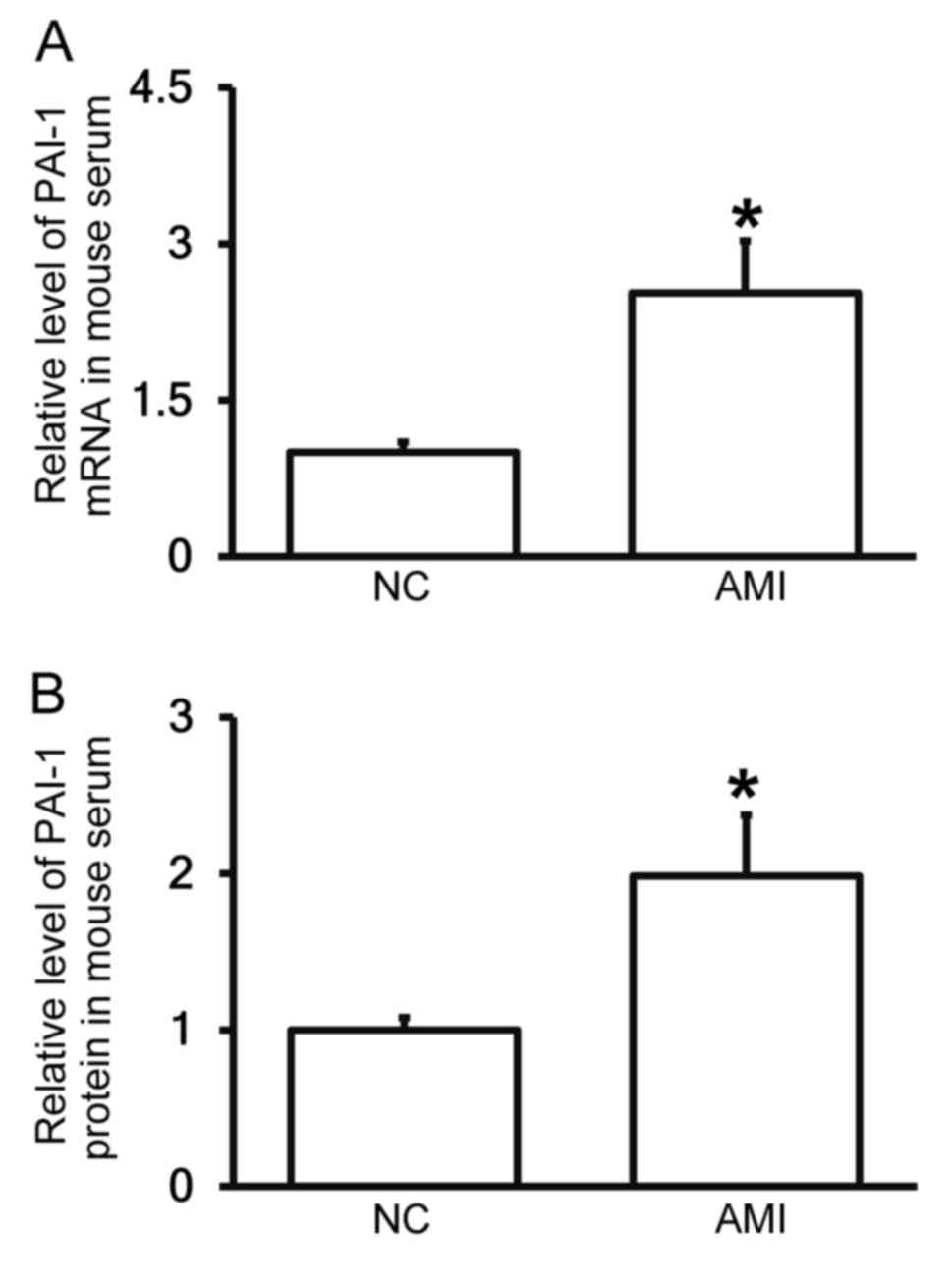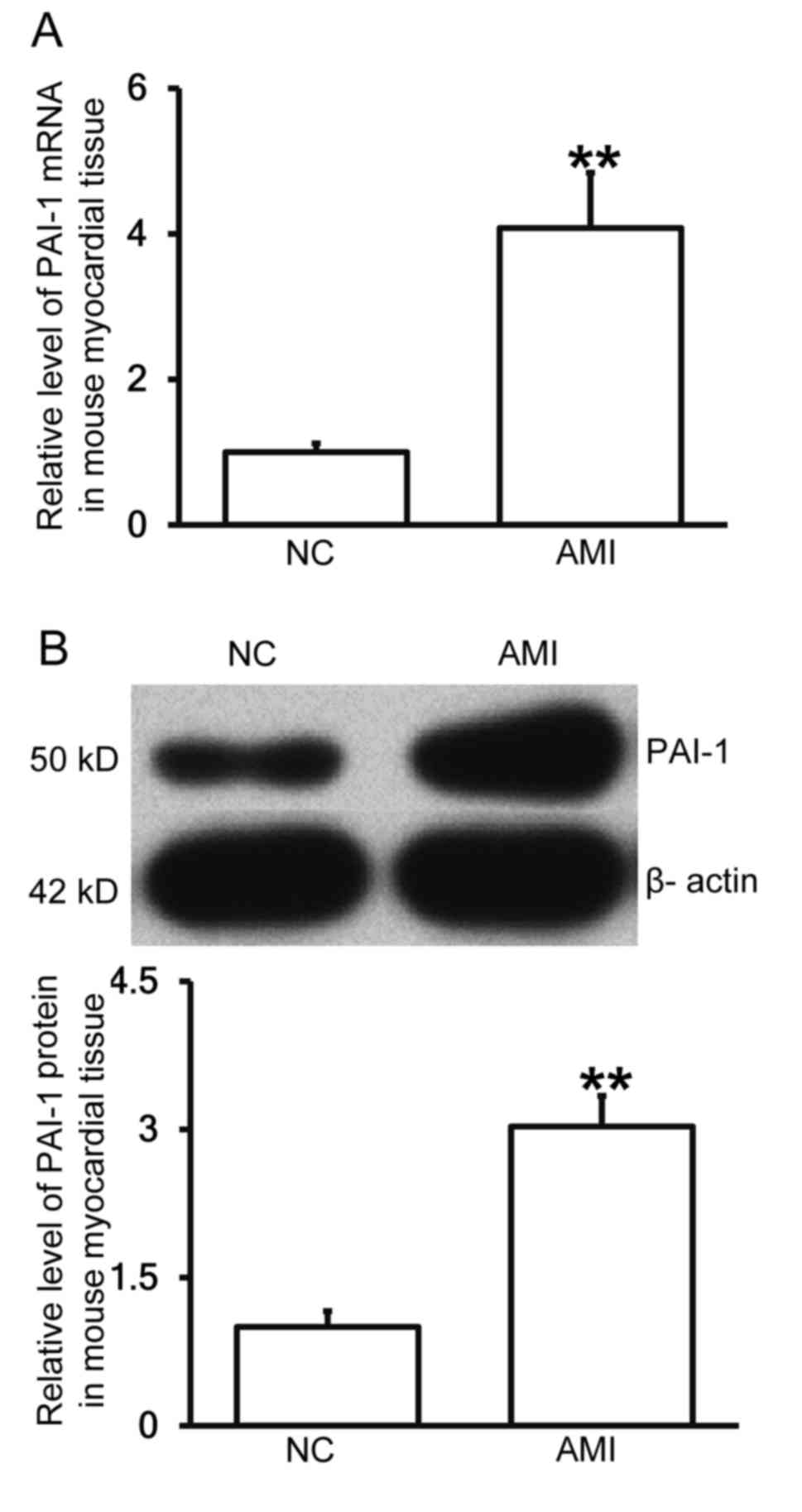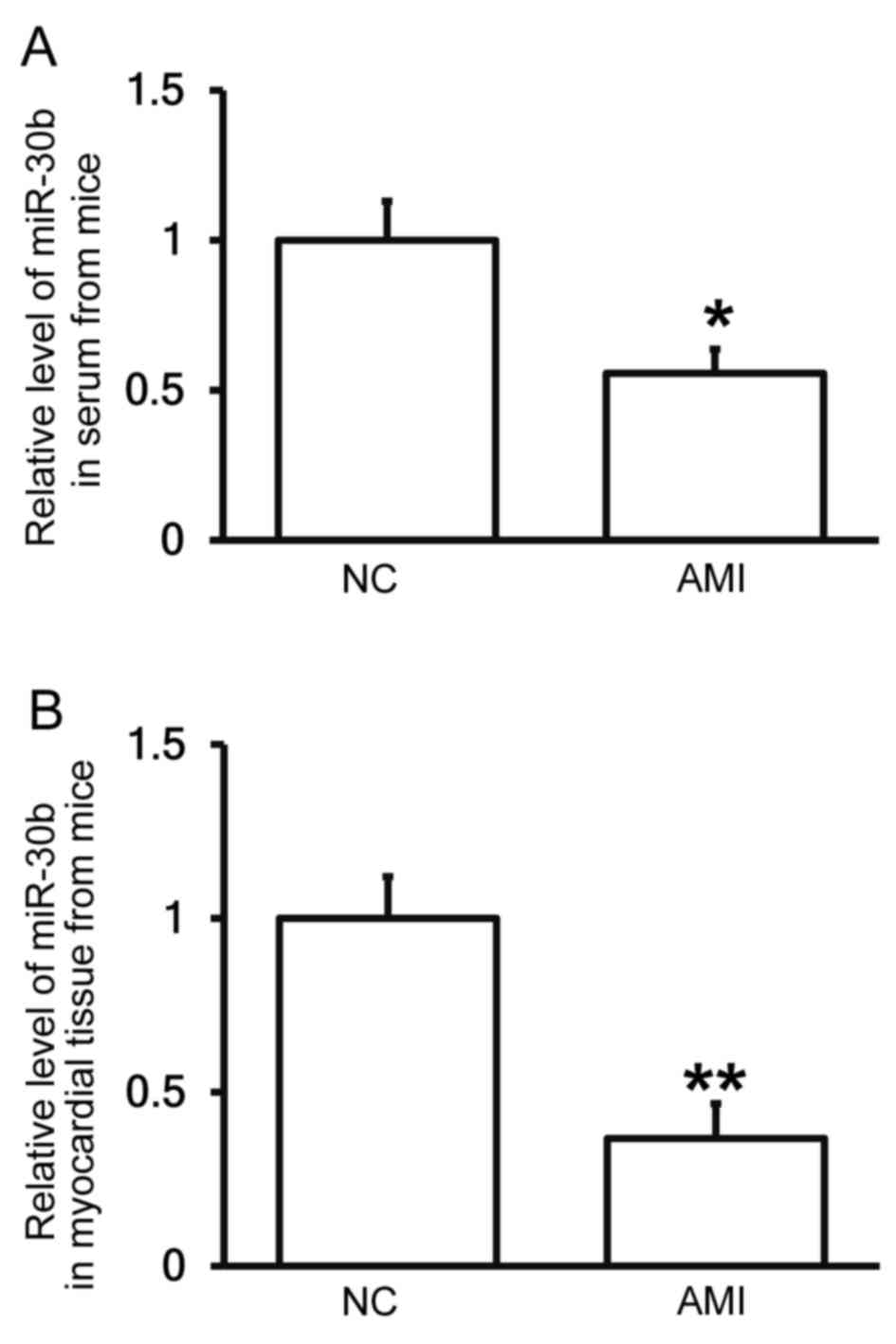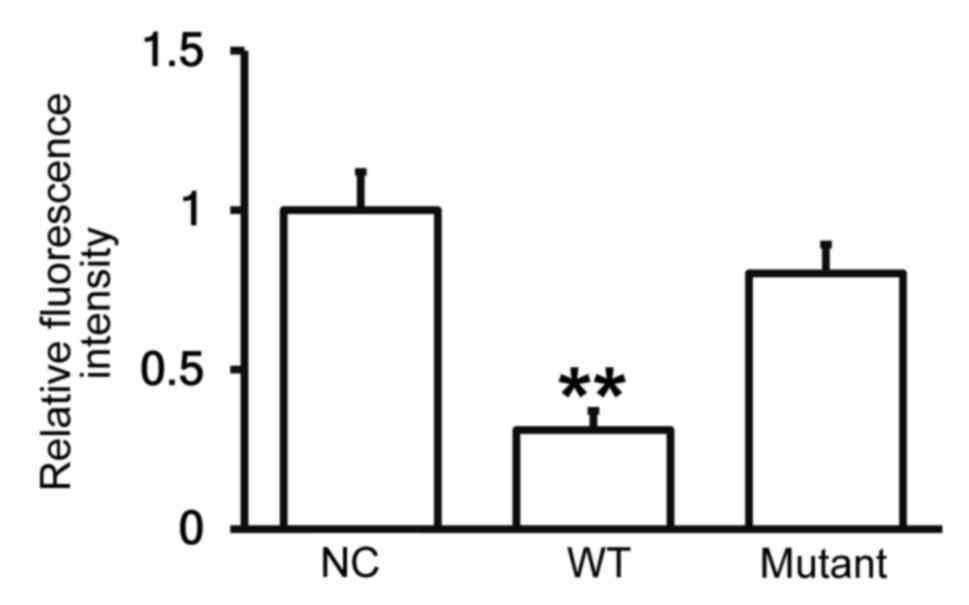MicroRNA‑30b protects myocardial cell function in patients with acute myocardial ischemia by targeting plasminogen activator inhibitor‑1
- Authors:
- Published online on: April 10, 2018 https://doi.org/10.3892/etm.2018.6039
- Pages: 5125-5132
Abstract
Introduction
Myocardial ischemia (MI) is one of the most severe cardiovascular diseases, which poses a serious threat to human health (1) and is expected to become the most common cause of mortality worldwide by 2030 (2). At present, 7.3 million people succumb to ischemic heart disease each year globally, which accounts for 12.8% of all mortalities due to disease (3). Acute myocardial ischemia (AMI) is usually caused by coronary atherosclerotic heart disease (4). A number of risk factors induce the formation of atherosclerosis in the coronary arteries, including aging, high blood pressure, high cholesterol, diabetes, smoking, lack of physical activity and obesity (5,6). This leads to narrowing or obstruction of the lumen, which in turn, causes MI, hypoxia and myocardial cell death, which is responsible for cardiac dysfunction (4). A number of studies have demonstrated that changes in coagulation and fibrinolysis stimulate the formation and development of atherosclerotic and thrombotic diseases. Coronary heart disease, particularly acute coronary syndrome, is closely associated with an increase in blood coagulation activity and a decrease in fibrinolytic activity (7,8). The treatment for MI primarily includes lifestyle changes, drug treatment and surgery. Lifestyle changes include maintaining a healthy diet and mental health. Drugs may be used to reduce blood lipid content, inhibit platelet aggregation and control angina pectoris, while surgical measures include coronary artery bypass grafting, atrioventricular valvuloplasty or replacement and ventricular reduction (9).
Plasminogen activator inhibitor-1 (PAI-1) is a serine protease inhibitor that inactivates tissue (t)- and urokinase-PA, inhibits intravascular fibrinolysis, causes changes in blood rheology and aggravates ischemic injury (10). In addition, PAI-1 is associated with the abnormal activation of platelets (11,12) and is a risk factor for the onset and development of ischemic heart and brain diseases (13,14).
Previous studies performing miRNA expression profiling have demonstrated that microRNA (miRNA) molecules serve important roles in the pathology of MI (15,16) and miRNAs regulate the expression of various genes by direct targeting mRNA (17,18). miRNAs that exist in the blood are also reliable biological markers associated with a number of diseases, including MI (19,20). It has been reported that miR-30b regulates the proliferation and apoptosis of gastric cancer cells by targeting PAI-1 (21). However, to the best of our knowledge, it remains unknown whether miR-30b regulates PAI-1 in MI. Therefore, in the present study, the expression of miR-30b and PAI-1 in the blood of patients with AMI and in the blood and myocardial tissue of mice with AMI was determined. The current study also aimed to understand the mechanism by which AMI occurs.
Materials and methods
Patients
A total of 36 patients aged 65.6±11.8 years old (range, 46–82 years) with AMI receiving treatment at the Luoyang Central Hospital Affiliated to Zhengzhou University (Luoyang, China) between August 2012 and January 2017 were included in the present study. Out of the 36 patients, there were 26 males and 10 females. A total of 21 patients received immediate treatment by percutaneous coronary intervention (PCI) and 15 patients received selective PCI at another time. A control group consisting of 28 healthy subjects (16 males and 12 females) aged 61.15±8.6 years old (range, 50–70 years old) were included in the current study. Peripheral blood was collected from patients with AMI within 6 h of MI onset and healthy subjects on the day of physical examination. Serum was isolated from peripheral blood by centrifugation at 4°C at 1,000 × g for 10 min. The present study was approved by the Ethics Committee of Zhengzhou University (Henan, China) and written informed consent was obtained from all participants or their families.
Animals
A total of 60 male BALB/C mice (4 weeks old; weighing 18–22 g) were purchased from Chongqing Tengxin Biotechnology Co., Ltd. (http://www.cqtx123.com/; Chongqing, China) with a numbered certificate [SCXK(Yu) 2015–0012]. For 1 week prior to the experiments, mice had ad libitum access to food and water. The animals were maintained at 24±2°C and 55±5% humidity in cages with a 12 h light/dark cycle. The Reduction, Replacement and Refinement animal welfare principle (22) was followed during the experiments. All mice were evenly divided into two groups (each, n=30): A control group and an AMI model group.
Following 1 week adaptive feeding, all mice received intraperitoneal injection of urethane (1,300 mg/kg) to induce anesthesia. Mice were kept in a supine position and needle electrodes were inserted into the subcutaneous layers of the limbs. An animal twelve-lead electrocardiograph (ECG-1350P; Nihon Kohden, Tokyo, Japan) was used to record a lead II electrocardiogram of normal mice (10 mm on the chart represented standard voltage 1 mV; chart speed, 50 ram/s). Mice in the AMI group were intraperitoneally injected with pituitrin (20 U/kg; Shanghai Pharma, Shanghai, China) to construct AMI mouse model. Mice in the control group were intraperitoneally injected with an equal volume of saline. After 30 min, the lead II electrocardiogram of mice in the control and AMI groups was recorded again. Changes in J point voltage on the electrocardiogram prior to and following ischemia were observed and the J point shift (mV) of each group was recorded using the PR segment as a baseline. A total of 30 min following construction of AMI mouse model, blood was collected from the eyes of mice under anesthetic in the control and AMI groups. The blood was then centrifuged at 1,200 × g for 15 min at 4°C to obtain serum. Subsequently, mice were sacrificed by decapitation, myocardial tissues were collected and stored in liquid nitrogen. All animal experiments were conducted according to the ethical guidelines of Zhengzhou University (Henan, China).
Reverse transcription-quantitative polymerase chain reaction (RT-qPCR)
Myocardial tissues (100 mg) were ground using liquid nitrogen and mixed with 1 ml TRIzol (10606ES60; Shanghai Yeasen Biotechnology, Co., Shanghai, China) for lysis. Serum samples (100 µl) were directly mixed with 1 ml TRIzol for lysis. Total RNA was then extracted using the phenol chloroform method as previously described (23). The concentration and quality of RNA was assessed using ultraviolet spectrophotometry (Nanodrop ND2000, Thermo Scientific, Inc., Wilmington, DE, USA). Reverse transcription of mRNA was performed using TIANScript II cDNA First Strand Synthesis kit (Tiangen Biotech Co., Ltd., Beijing, China) and reverse transcription of miRNA was performed using an miRcute miRNA cDNA First Strand Synthesis kit (Tiangen Biotech, Co., Ltd.). cDNA was stored at −20°C. A SuperReal PreMix (SYBR Green) RT-qPCR kit (Tiangen Biotech, Co., Ltd.) was used to detect the expression of PAI-1 mRNA. The sequences of the primers used to detect human PAI-1 were: PAI-1, forward, 5′-AATGACTGGGTGAAGACACACACA-3′ and reverse, 5′-TTCCACTGGCCGTTGAAGTAGA-3′; β-actin, forward, 5′-TGGCACCCAGCACAATGAA-3′ and reverse, 5′-CTAAGTCATAGTCCGCCTAGAAGCA-3′. The sequences of the primers used to detect mouse PAI-1 were as follows: PAI-1, forward, 5′-AGGGCTTCATGCCCCACTTCTTCA-3′ and reverse, 5′-AGTAGAGGGCATTCACCAGCACCA-3′; GAPDH, forward, 5′-CAAGGTCATCCATGACAACTTTG-3′ and reverse, 5′-GTCCACCACCCTGTTGCTGTAG-3′. The qPCR reaction system (20 µl) to detect PAI-1 consisted of 10 µl RT-qPCR-Mix, 0.5 µl upstream primer, 0.5 µl downstream primer, 2 µl cDNA and 7 µl ddH2O. The qPCR conditions were as follows: Initial denaturation at 95°C for 2 min; 40 cycles of denaturation at 95°C for 25 sec, annealing at 55°C for 30 sec and elongation at 72°C for 30 sec; final extension at 72°C for 30 sec. qPCR was performed using an iQ5 Real-Time PCR system (Bio-Rad Laboratories, Inc., Hercules, CA, USA). The 2−ΔΔCq method (24) was used to calculate the relative expression of human PAI-1 mRNA against β-actin and the relative expression of mouse PAI-1 mRNA against GAPDH. Each sample was tested in triplicate.
The expression of miR-30b was determined using the miRcute miRNA RT-PCR kit (Tiangen Biotech, Co., Ltd), using U6 as internal reference. The sequences of the primers used to detect human miR-30b were: Forward, 5′-CGCGCTGTAAACATCCTACAC-3′ and reverse, 5′-GTGCAGGGTCCGAGGT-3′; U6, forward, 5′-GCTTCGGCAGCACATATACTAAAAT-3′ and reverse, 5′-CGCTTCACGAATTTGCGTGTCAT-3′. The PCR reaction system (20 µl) for human miR-30b determination was composed of 10 µl RT-qPCR-Mix, 0.5 µl upstream primer, 0.5 µl downstream primer, 2 µl cDNA and 7 µl ddH2O. PCR conditions for human miR-30b determination were: Initial denaturation at 95°C for 5 min; 40 cycles of denaturation 95°C for 10 sec, annealing at 60°C for 20 sec and elongation at 72°C for 10 sec; final extension at 72°C for 5 min. qPCR was performed using the iQ5 Real-Time PCR system.
The sequences used to detect mouse miR-30b were, forward, 5′-GCGCCTGTAAACATCCTACAC-3′ and reverse, 5′-GTGCAGGGTCCGAGGT-3′; U6, forward, 5′-GCTTCGGCAGCACATATACTAA-3′ and reverse, 5′-AACGCTTCACGAATTTGCGT-3′. The PCR reaction system (25 µl) for mouse miR-30b determination was composed of 12.5 µl SYBR Premix EXTaq™ (Takara Biotechnology Co., Ltd., Dalian, China), 0.5 µl upstream primer, 0.5 µl downstream primer, 1 µl cDNA and 10.5 µl ddH2O. qPCR conditions for mouse miR-30b determination were: Initial denaturation at 95°C for 30 sec; 45 cycles of denaturation at 95°C denaturation for 5 sec and annealing at 60°C for 30 sec; elongation at 72°C for 45 sec; final extension at 72°C for 5 min. qPCR was performed using an iQ5 Real-Time PCR system. The 2−ΔΔCq method was used to calculate the relative expression of miR-30b against U6. Each sample was tested in triplicate.
Enzyme-linked immunosorbent assay (ELISA)
Sera were examined using human and mouse PAI-1 ELISA kits [cat. nos. ab108891 (human) and ab197752 (mouse); Abcam, Cambridge, UK] according to the manufacturer's protocol. In microplates, standards (50 µl), samples (10 µl sample liquid and 40 µl diluent) and blank were set into predefined wells. In the wells for standards and samples, horseradish peroxidase-labelled conjugates (100 µl) were added before sealing the plates for incubation at 37°C for 1 h. The plates were washed 5 times and then substrates A (50 µl) and B (50 µl) were added to each well. Following incubation at 37°C for 15 min, stop solution (50 µl) was added to each well and the absorbance of each well was measured at 450 nm.
Western blotting
Precooled radioimmunoprecipitation assay lysis buffer (600 µl; 50 mM Tris-base, 1 mM EDTA, 150 mM NaCl, 0.1% sodium dodecyl sulfate, 1% Triton X-100, 1% sodium deoxycholate; Beyotime Institute of Biotechnology, Haimen, China) was used to lyse the samples. Following lysis for 50 min on ice, the mixture was centrifuged at 18,000 × g and 4°C for 5 min. Protein concentration of the supernatant was determined using a bicinchoninic acid protein concentration determination kit [RTP7102; Real-Times (Beijing) Biotechnology Co., Ltd., Beijing, China]. Protein samples (20 µg) were then mixed with SDS loading buffer prior to denaturation in a boiling water bath for 5 min. The samples were then subjected to 10% SDS-PAGE. Resolved proteins were transferred to polyvinylidene difluoride membranes on ice (100 V, 2 h) and blocked with 5% skimmed milk at room temperature for 1 h. Subsequently, membranes were incubated with rabbit anti-mouse PAI-1 polyclonal (1:1,000; cat. no. ab7205; Abcam) and rabbit anti-mouse β-actin (1:5,000; cat. no. ab8227; Abcam) primary antibodies at 4°C overnight. Following three washes with phosphate-buffered saline with Tween 20 (15 min/wash), membranes were incubated with goat anti-rabbit horseradish peroxidase-conjugated secondary antibody (1:3,000; cat. no. ab6721; Abcam) for 1 h at room temperature prior to three washes with phosphate-buffered saline with Tween 20 (15 min/wash). The membrane was developed using an enhanced chemiluminescence detection kit (Abcam). Image lab v3.0 software (Bio-Rad Laboratories, Inc.) was used to acquire and analyze imaging signals. The relative content of PAI-1 protein was expressed as the ratio of PAI-1/β-actin.
Bioinformatics
Bioinformatics prediction is a powerful tool to study the function of miRNAs. To determine the regulatory mechanism of PAI-1, miRanda (http://www.microrna.org/microrna/home.do), TargetScan (http://www.targetscan.org), PiTa (http://genie.weizmann.ac.il/pubs/mir07/mir07_data.html), RNAhybrid (http://bibiserv.techfak.uni-bielefeld.de/rnahybrid/) and PICTA (http://pictar.mdc-berlin.de/) were used to predict the miRNA molecules that may regulate PAI-1. The results indicated that miR-30b was potentially able to regulate PAI-1 (Fig. 1).
Automatic biochemical analysis
The activities of catalase (CAT; cat. no. A007-1-1), glutathione peroxidase (GSH-Px; cat. no. A005) and superoxide dismutase (SOD; cat. no. A001-2-1) were determined using the appropriate kits (Nanjing Jiancheng Bioengineering Institute, Nanjing, China) following the manufacturer's protocol. Following the addition of all reagents, absorbance was measured continuously over a 5 min period. The activities of CAT, GSH-Px and SOD were determined by the increase rate of average absorbance per minute in the linear segment. The results were automatically calculated using an AU5800 automatic biochemical analyzer (Beckman Coulter, Inc., Brea, CA, USA).
Dual luciferase reporter assay
The results of bioinformatics were used to chemically synthesize the wild-type (WT) and mutant seed regions of miR-30b in the 3′-untranslated region (UTR) of PAI-1 gene in vitro. SpeI and HindIII restriction sites were added and UTRs were then cloned into pMIR-REPORT luciferase reporter plasmids (Thermo Fisher Scientific, Inc., Waltham, MA, USA). Plasmids (0.8 µg) containing WT or mutant 3′-UTR DNA sequences were co-transfected with agomiR-30b (100 nM; Sangon Biotech, Co., Ltd., Shanghai, China) into 293T cells using Lipofectamine® 2000 (Invitrogen; Thermo Fisher Scientific, Inc.). Following 24 h cultivation, activity was assessed using a dual luciferase reporter assay kit (Promega Corporation, Madison, WI, USA), following the manufacturer's protocol and fluorescence intensity was measured using a GloMax 20/20 luminometer (Promega Corporation). Using Renilla luciferase fluorescence activity as an internal reference, the fluorescence values of each group of cells were measured.
Statistical analysis
The results were analyzed using SPSS 18.0 statistical software (SPSS, Inc., Chicago, IL, USA). All data are expressed as the mean ± standard deviations. Data were tested for normality. Multigroup measurement data were analyzed using one-way analysis of variance. In cases of homogeneity of variance, the Least Significant Difference and Student-Newman-Keuls methods were used as a post-hoc test; in cases of heterogeneity of variance, Tamhane's T2 or Dunnett's T3 method was used. P<0.05 was determined to indicate a statistically significant difference.
Results
Patients with AMI exhibit elevated PAI-1 expression in the peripheral blood
To measure the expression of PAI-1 mRNA and protein in the serum of patients with AMI compared with healthy controls, RT-qPCR and ELISA were performed. The results demonstrated that levels of PAI-1 mRNA and protein in the serum of patients with AMI were significantly higher than in healthy controls (P<0.01 and P<0.05; Fig. 2A and B, respectively), confirming that patients with AMI exhibit elevated PAI-1 expression in the peripheral blood.
Patients with AMI exhibit reduced miR-30b levels in the peripheral blood
To measure the expression of miR-30b in the peripheral blood of patients and healthy controls, RT-qPCR was performed. The results demonstrated that the expression of miR-30b in the serum of patients with AMI was significantly decreased compared with the control group (P<0.05; Fig. 3), indicating that patients AMI exhibit decreased miR-30b expression.
The J point voltage in electrocardiogram is enhanced and the activities of SOD, CAT and GSH-Px are decreased in mice with AMI
To determine changes in the associated physiological and biochemical indexes in the mouse model of AMI, electrocardiography and an automatic biochemical analyzer were used. The results indicated that the J point voltage in mice with AMI was significantly higher than mice in the negative control group (P<0.05; Table I). In addition, the activity of SOD, CAT and GSH-Px in the peripheral blood of mice with AMI was significantly increased compared with mice in the negative control group (all P<0.05). These results indicate that AMI may enhance the J point voltage and decrease SOD, CAT and GSH-Px activity.
AMI model mice exhibit increased PAI-1 levels in the peripheral blood
To measure the expression of PAI-1 mRNA and protein in the serum of mice, RT-qPCR and ELISA were performed. The results demonstrated that levels of PAI-1 mRNA and protein in the serum of mice with AMI were significantly higher than in the negative control group (each P<0.05; Fig. 4A and B). These results suggest that PAI-1 levels are increased in the blood following AMI and are consistent with the results from patients with AMI.
Mice with AMI exhibit increased PAI-1 expression in myocardial tissue
To determine the levels of PAI-1 mRNA and protein in myocardial tissue, RT-qPCR and western blotting were performed. The results demonstrated that levels of PAI-1 mRNA and protein in the myocardial tissues of mice with AMI were significantly higher than those in the negative control group (each P<0.01; Fig. 5A and B), indicating that mice with AMI exhibit increased PAI-1 expression.
Mice with AMI exhibit decreased miR-30b levels in the peripheral blood and myocardial tissues
To determine the expression of miR-30b in the peripheral blood and myocardial tissue of mice, RT-qPCR was conducted. The results demonstrated that the expression of miR-30b in the serum and myocardial tissues of mice with AMI was significantly reduced compared with the negative control group (P<0.05 and P<0.01; Fig. 6A and B, respectively), indicating that mice with AMI exhibit decreased miR-30b levels.
miR-30b is able to bind to the 3′-UTR seeding region of PAI-1 mRNA to regulate its expression
To identify the interaction between miR-30b and the 3′-UTR of human PAI-1 mRNA, a dual luciferase reporter assay was performed. The fluorescence value of cells co-transfected with agomiR-30b and pMIR-REPORT-WT luciferase reporter plasmids was significantly lower than that of the negative control group (P<0.01; Fig. 7). By contrast, the fluorescence value of cells co-transfected with agomiR-30b and pMIR-REPORT-mutant luciferase reporter plasmid did not differ significantly to that of the negative control group (Fig. 7). These results indicate that miR-30b is able to bind to the 3′-UTR seeding region of PAI-1 mRNA, thus regulating its expression.
Discussion
MI is a pathological condition in which blood perfusion of the heart is decreased, the oxygen supply to the heart is reduced and myocardium metabolism is deregulated (25). Due to the increased availability of high-energy, processed food and the adoption of more sedentary lifestyles (5), the prevalence of MI in China is increasing (26). MI is usually caused by vasculopathy and an insufficient blood supply to the heart (27,28). Vasculopathy is associated with abnormal changes in blood coagulation and fibrinolysis and is a primary cause of thrombosis (29,30). tPA and PAI-1 are important active substances in the fibrinolytic system and PAI-1 inhibits the action of tPA. It has been reported that PAI-1 and tPA are closely associated with ischemic cardiovascular disease (31,32). PAI-1 is also closely associated with vascular disease and participates in the accumulation of extracellular matrix, as well as the proliferation and migration of smooth muscle cells. It also stimulates the binding of low-density lipoprotein to vascular smooth muscle cells (33,34). PAI-1 deposits in the extracellular matrix facilitate the formation of atherosclerotic plaques, thicken the vascular basement membrane and stiffen the vascular walls, thus promoting the onset and development of vasculopathy and therefore atherosclerosis (35–37). PAI-1 is considered to be closely associated with vascular disease (38); therefore, it is important to determine the regulatory mechanism of action of PAI-1.
The present study identified the relevant factors in AMI in the peripheral blood. Subsequently, an AMI mouse model was constructed using pituitrin. The animal model of MI induced by pituitrin has been widely used in the screening of anti-MI drugs (39,40) and the progression of AMI and the pathological changes that occur in this particular mouse model are very similar to what occurs in patients with AMI. The results of the current study demonstrated that the expression of PAI-1 in the serum of patients with AMI is upregulated, indicating that abnormal changes in coagulation and fibrinolysis occur in such patients. The results of the electrocardiogram confirmed the successful construction of the AMI mouse model.
Maintaining the balance of free radicals in the blood is dependent on the activity of the free radical-scavenging enzymes SOD, CAT and GSH-Px (41–43). When tissues and cells are ischemic and anoxic, the function of the scavenging system is impaired, the activities of these enzymes decrease and they react with the proteins and nucleic acids in the cells. This causes a cascade of changes in cell structure and function that eventually damages myocardial cells (41–43). In the current study, upregulation of PAI-1 expression in the blood and myocardium of mice was also observed, further indicating that PAI-1 serves an important role in AMI.
miRNAs are posttranscriptional regulators. It has been reported that miRNAs participate in various cardiac physiological and pathological processes, including cardiac development, cardiac hypertrophy, heart failure and vascular proliferation (44). Wang et al (45) demonstrated that miR-142-3p protects against damage in the cardiomyocytes induced by hypoxia/reoxygenation by targeting the high mobility group box 1 gene. Singh et al (46) reported that miR-200c directly regulates the expression of dual specificity protein phosphatase 1, downregulates the activity of the mitogen-activated protein kinase signaling pathway and promotes cardiomyocyte hypertrophy. Based on the results of a study investigating the regulation of PAI-1 by miRNA (47), the present study used bioinformatics to identify the miRNA that regulates PAI-1 expression; the results indicated that miR-30b regulates PAI-1. Previous studies have demonstrated that miR-30b affects the proliferation and apoptosis of coronary artery endothelial cells via integrin subunit α 4, phospholipase γ 1 (48), caspase 3 (49) and Bcl-2 (50). Furthermore, myocardial miR-30b serves anti-apoptotic and protective roles during the pathological process of heart ischemia reperfusion (51,52). These studies suggest that miR-30b may be closely associated with the onset and development of heart disease in humans. The results of the present study indicate that the expression of miR-30b in the blood of patients with AMI is significantly decreased. Furthermore, the expression of PAI-1 is abnormally high in the blood of patients with AMI. This suggests that the downregulation of miR-30b may stimulate the upregulation of PAI-1. The current study obtained similar results regarding miR-30b and PAI-1 expression in the blood and myocardial tissues of mice with AMI, indicating that miR-30b negatively regulates PAI-1 in other species as well as humans. Furthermore, the results of the dual luciferase reporter assay indicated that miR-30b regulates the expression of PAI-1 by directly targeting the 3′-UTR of PAI-1 mRNA.
In conclusion, the results of the present study demonstrate that the expression of miR-30b is reduced and the expression of PAI-1 is increased following AMI and that these changes alter the expression of t-PA and u-PA proteins. Therefore, miR-30b serves an important role in AMI and may be developed as a potential biomarker in the diagnosis and treatment of AMI.
Acknowledgements
Not applicable.
Funding
No funding was received.
Availability of data and materials
The analyzed data sets generated during the study are available from the corresponding author on reasonable request.
Author contributions
BL conceived and designed the study, performed experiments and collected and analyzed the data. JH collected and analyzed data. XC conceived and designed the study, drafted and revised the manuscript and gave final approval of version to be published. The final version of the manuscript has been read and approved by all authors.
Ethical approval and consent to participate
All procedures performed in the current study were approved by the Ethics Committee of Zhengzhou University. Written informed consent was obtained from all patients or their families.
Consent for publication
Written informed consent was obtained from all participants or their families for the publication of their data.
Competing interests
The authors declare that they have no competing interests.
References
|
Nabel EG and Braunwald E: A tale of coronary artery disease and myocardial infarction. N Engl J Med. 366:54–63. 2012. View Article : Google Scholar : PubMed/NCBI | |
|
Mathers CD and Loncar D: Projections of global mortality and burden of disease from 2002 to 2030. PLoS Med. 3:e4422006. View Article : Google Scholar : PubMed/NCBI | |
|
Zhou H, Ma Q, Zhu P, Ren J, Reiter RJ and Chen Y: Protective role of melatonin in cardiac ischemia-reperfusion injury: From pathogenesis to targeted therapy. J Pineal Res. 64:e124712018. View Article : Google Scholar | |
|
Fuke Y, Yasutsune T and Sakamoto M: Aortic valve replacement after coronary artery bypass grafting with the in situ right gastroepiploic artery to the occluded right coronary artery using a temporary vein graft for cardioplegia. Surg Case Rep. 3:562017. View Article : Google Scholar : PubMed/NCBI | |
|
Orth-Gomér K, Deter HC, Grün AS, Herrmann-Lingen C, Albus C, Bosbach A, Ladwig KH, Ronel J, Söllner W, de Zwaan M, et al: Socioeconomic factors in coronary artery disease-results from the SPIRR-CAD study. J Psychosom Res. 105:125–131. 2018. View Article : Google Scholar : PubMed/NCBI | |
|
Kundi H, Kiziltunc E, Korkmaz A, Cicek G, Ornek E and Ileri M: A novel risk scoring system to predict cardiovascular death in patients with acute myocardial infarction: CHA2DS2-VASc-CF score. Clin Appl Thromb Hemost. 24:273–278. 2018. View Article : Google Scholar : PubMed/NCBI | |
|
Folsom AR, Aleksic N, Park E, Salomaa V, Juneja H and Wu KK: Prospective study of fibrinolytic factors and incident coronary heart disease: The atherosclerosis risk in communities (ARIC) study. Arterioscler Thromb Vasc Biol. 21:611–617. 2001. View Article : Google Scholar : PubMed/NCBI | |
|
Rosenfeld ME: An overview of the evolution of the atherosclerotic plaque: From fatty streak to plaque rupture and thrombosis. Z Kardiol. 89 Suppl 7:S2–S6. 2000. View Article : Google Scholar | |
|
Moran AE, Forouzanfar MH, Roth GA, Mensah GA, Ezzati M, Murray CJ and Naghavi M: Temporal trends in ischemic heart disease mortality in 21 world regions, 1980 to 2010: The global burden of disease 2010 study. Circulation. 129:1483–1492. 2014. View Article : Google Scholar : PubMed/NCBI | |
|
Hua Y, Xi G, Keep RF, Wu J, Jiang Y and Hoff JT: Plasminogen activator inhibitor-1 induction after experimental intracerebral hemorrhage. J Cereb Blood Flow Metab. 22:55–61. 2002. View Article : Google Scholar : PubMed/NCBI | |
|
Pieters M, Barnard SA, Loots DT and Rijken DC: The effects of residual platelets in plasma on plasminogen activator inhibitor-1 and plasminogen activator inhibitor-1-related assays. PloS One. 12:e01712712017. View Article : Google Scholar : PubMed/NCBI | |
|
Deng ZY, Shan WG, Wang SF, Hu MM and Chen Y: Effects of astaxanthin on blood coagulation, fibrinolysis and platelet aggregation in hyperlipidemic rats. Pharm Biol. 55:663–672. 2017. View Article : Google Scholar : PubMed/NCBI | |
|
Eitzman DT, Westrick RJ, Xu Z, Tyson J and Ginsburg D: Plasminogen activator inhibitor-1 deficiency protects against atherosclerosis progression in the mouse carotid artery. Blood. 96:4212–4215. 2000.PubMed/NCBI | |
|
Kohler HP and Grant PJ: Plasminogen-activator inhibitor type 1 and coronary artery disease. N Engl J Med. 342:1792–1801. 2000. View Article : Google Scholar : PubMed/NCBI | |
|
Chang TY, Tsai WC, Huang TS, Su SH, Chang CY, Ma HY, Wu CH, Yang CY, Lin CH, Huang PH, et al: Dysregulation of endothelial colony-forming cell function by a negative feedback loop of circulating miR-146a and −146b in cardiovascular disease patients. PLoS One. 12:e01815622017. View Article : Google Scholar : PubMed/NCBI | |
|
Satoh M, Nasu T, Takahashi Y, Osaki T, Hitomi S, Morino Y and Nakamura M: Expression of miR-23a induces telomere shortening and is associated with poor clinical outcomes in patients with coronary artery disease. Clin Sci (Lond). 131:2007–2017. 2017. View Article : Google Scholar : PubMed/NCBI | |
|
Inoue K: MicroRNA function in animal development. Tanpakushitsu Kakusan Koso. 52:197–204. 2007.(In Japanese). PubMed/NCBI | |
|
Looney AM, Ahearne CE, Hallberg B, Boylan GB and Murray DM: Downstream mRNA target analysis in neonatal hypoxic-ischaemic encephalopathy identifies novel marker of severe injury: A proof of concept paper. Mol Neurobiol. 54:8420–8428. 2017. View Article : Google Scholar : PubMed/NCBI | |
|
Li S, Lee C, Song J, Lu C, Liu J, Cui Y, Liang H, Cao C, Zhang F and Chen H: Circulating microRNAs as potential biomarkers for coronary plaque rupture. Oncotarget. 8:48145–48156. 2017.PubMed/NCBI | |
|
Wang Q, Ma J, Jiang Z, Wu F, Ping J and Ming L: Identification of microRNAs as diagnostic biomarkers for acute myocardial infarction in Asian populations: A systematic review and meta-analysis. Medicine (Baltimore). 96:e71732017. View Article : Google Scholar : PubMed/NCBI | |
|
Zhu ED, Li N, Li BS, Li W, Zhang WJ, Mao XH, Guo G, Zou QM and Xiao B: miR-30b, down-regulated in gastric cancer, promotes apoptosis and suppresses tumor growth by targeting plasminogen activator inhibitor-1. PloS One. 9:e1060492014. View Article : Google Scholar : PubMed/NCBI | |
|
Clark MacArthur J: The 3Rs in research: A contemporary approach to replacement, reduction and refinement. Br J Nutr. 1–7. 2017. View Article : Google Scholar | |
|
Nwokeoji AO, Kilby PM, Portwood DE and Dickman MJ: RNASwift: A rapid, versatile RNA extraction method free from phenol and chloroform. Anal Biochem. 512:36–46. 2016. View Article : Google Scholar : PubMed/NCBI | |
|
Livak KJ and Schmittgen TD: Analysis of relative gene expression data using real-time quantitative PCR and the 2(-Delta Delta C(T)) method. Methods. 25:402–408. 2001. View Article : Google Scholar : PubMed/NCBI | |
|
Zhang P, Wu X, Li G, He Q, Dai H, Ai C and Shi J: Tumor necrosis factor-alpha gene polymorphisms and susceptibility to ischemic heart disease: A systematic review and meta-analysis. Medicine (Baltimore). 96:e65692017. View Article : Google Scholar : PubMed/NCBI | |
|
Xiao FY, Liu M, Chen BL, Cao S, Fan L, Liu ZQ, Zhou HH, Zhang W and Zhou G: Effects of four novel genetic polymorphisms on clopidogrel efficacy in Chinese acute coronary syndromes patients. Gene. 623:63–71. 2017. View Article : Google Scholar : PubMed/NCBI | |
|
Chistiakov DA, Grechko AV, Myasoedova VA, Melnichenko AA and Orekhov AN: Impact of the cardiovascular system-associated adipose tissue on atherosclerotic pathology. Atherosclerosis. 263:361–368. 2017. View Article : Google Scholar : PubMed/NCBI | |
|
Al Badarin F, Aljizeeri A, Almasoudi F and Al-Mallah MH: Assessment of myocardial blood flow and coronary flow reserve with positron emission tomography in ischemic heart disease: Current state and future directions. Heart Fail Rev. 22:441–453. 2017. View Article : Google Scholar : PubMed/NCBI | |
|
Tanabe N, Hiraoka E, Hoshino M, Deshpande GA, Sawada K, Norisue Y, Tsukuda J and Suzuki T: Progressive ischemic stroke due to thyroid storm-associated cerebral venous thrombosis. Am J Case Rep. 18:194–197. 2017. View Article : Google Scholar : PubMed/NCBI | |
|
Moreno JA, Gálvez MM, Cornudella R, Angós JA, Romero MS and Gutiérrez M: Fibrinolytic system in patients with myocardial infarction and other coronary disease risk factors. Sangre (Barc). 39:111–116. 1994.(In Spanish). PubMed/NCBI | |
|
Iida K, Tani S, Atsumi W, Yagi T, Kawauchi K, Matsumoto N and Hirayama A: Association of plasminogen activator inhibitor-1 and low-density lipoprotein heterogeneity as a risk factor of atherosclerotic cardiovascular disease with triglyceride metabolic disorder: A pilot cross-sectional study. Coron Artery Dis. 28:577–587. 2017. View Article : Google Scholar : PubMed/NCBI | |
|
Shimizu T, Uematsu M, Yoshizaki T, Obata JE, Nakamura T, Fujioka D, Watanabe K, Watanabe Y and Kugiyama K: Myocardial production of plasminogen activator inhibitor-1 is associated with coronary endothelial and ventricular dysfunction after acute myocardial infarction. J Atheroscler Thromb. 23:557–566. 2016. View Article : Google Scholar : PubMed/NCBI | |
|
Denorme F, Wyseure T, Peeters M, Vandeputte N, Gils A, Deckmyn H, Vanhoorelbeke K, Declerck PJ and De Meyer SF: Inhibition of thrombin-activatable fibrinolysis inhibitor and plasminogen activator inhibitor-1 reduces ischemic brain damage in mice. Stroke. 47:2419–2422. 2016. View Article : Google Scholar : PubMed/NCBI | |
|
Seferovic MD and Gupta MB: Increased umbilical cord PAI-1 levels in placental insufficiency are associated with fetal hypoxia and angiogenesis. Dis Markers. 2016:71241862016. View Article : Google Scholar : PubMed/NCBI | |
|
Ji Y, Meng QH and Wang ZG: Changes in the coagulation and fibrinolytic system of patients with subarachnoid hemorrhage. Neurol Med Chir (Tokyo). 54:457–464. 2014. View Article : Google Scholar : PubMed/NCBI | |
|
Thögersen AM, Jansson JH, Boman K, Nilsson TK, Weinehall L, Huhtasaari F and Hallmans G: High plasminogen activator inhibitor and tissue plasminogen activator levels in plasma precede a first acute myocardial infarction in both men and women: Evidence for the fibrinolytic system as an independent primary risk factor. Circulation. 98:2241–2247. 1998. View Article : Google Scholar : PubMed/NCBI | |
|
Hamsten A, de Faire U, Walldius G, Dahlén G, Szamosi A, Landou C, Blombäck M and Wiman B: Plasminogen activator inhibitor in plasma: Risk factor for recurrent myocardial infarction. Lancet. 2:3–9. 1987. View Article : Google Scholar : PubMed/NCBI | |
|
Chen R, Yan J, Liu P, Wang Z and Wang C: Plasminogen activator inhibitor links obesity and thrombotic cerebrovascular diseases: The roles of PAI-1 and obesity on stroke. Metab Brain Dis. 32:667–673. 2017. View Article : Google Scholar : PubMed/NCBI | |
|
Li JY, Li Y, Gong HY, Zhao XB and Li LZ: Protective effects of n-butanol extract of Potentilla anserina on acute myocardial ischemic injury in mice. Zhong Xi Yi Jie He Xue Bao. 7:48–52. 2009.(In Chinese). View Article : Google Scholar : PubMed/NCBI | |
|
Fu XC, Wang X, Zheng H and Ma LP: Protective effects of orientin on myocardial ischemia and hypoxia in animal models. Nan Fang Yi Ke Da Xue Xue Bao. 27:1173–1175. 2007.(In Chinese). PubMed/NCBI | |
|
Maenpaa CJ, Shames BD, Van Why SK, Johnson CP and Nilakantan V: Oxidant-mediated apoptosis in proximal tubular epithelial cells following ATP depletion and recovery. Free Radic Biol Med. 44:518–526. 2008. View Article : Google Scholar : PubMed/NCBI | |
|
Kim JK, Pedram A, Razandi M and Levin ER: Estrogen prevents cardiomyocyte apoptosis through inhibition of reactive oxygen species and differential regulation of p38 kinase isoforms. J Biol Chem. 281:6760–6767. 2006. View Article : Google Scholar : PubMed/NCBI | |
|
Castedo E, Segovia J, Escudero C, Olmedilla B, Granado F, Blas C, Guardiola JM, Millán I, Pulpón LA and Ugartea J: Ischemia-reperfusion injury during experimental heart transplantation. Evaluation of trimetazidine's cytoprotective effect. Rev Esp Cardiol. 58:941–950. 2005.(In Spanish). View Article : Google Scholar : PubMed/NCBI | |
|
Bardooli F, McAlindon E, Littlejohns B, Suleiman MS, Bucciarelli-Ducci C and Baumbach A: TCT-184 Early changes in circulating miRNA 133a are indicative of cardiac remodelling after 3 months in patients presenting with acute ST elevation myocardial infarction. J Am Coll Cardiol. 68:B75–B76. 2016. View Article : Google Scholar | |
|
Wang Y, Ouyang M, Wang Q and Jian Z: MicroRNA-142-3p inhibits hypoxia/reoxygenationinduced apoptosis and fibrosis of cardiomyocytes by targeting high mobility group box 1. Int J Mol Med. 38:1377–1386. 2016. View Article : Google Scholar : PubMed/NCBI | |
|
Singh GB, Raut SK, Khanna S, Kumar A, Sharma S, Prasad R and Khullar M: MicroRNA-200c modulates DUSP-1 expression in diabetes-induced cardiac hypertrophy. Mol Cell Biochem. 424:1–11. 2017. View Article : Google Scholar : PubMed/NCBI | |
|
Li X, Gao Y, Meng Z, Zhang C and Qi Q: Regulatory role of microRNA-30b and plasminogen activator inhibitor-1 in the pathogenesis of cognitive impairment. Exp Ther Med. 11:1993–1998. 2016. View Article : Google Scholar : PubMed/NCBI | |
|
Ma F, Li T, Zhang H and Wu G: MiR-30s family inhibit the proliferation and apoptosis in human coronary artery endothelial cells through targeting the 3′UTR region of ITGA4 and PLCG1. J Cardiovasc Pharmacol. 68:327–333. 2016. View Article : Google Scholar : PubMed/NCBI | |
|
Li F, Chen Q, Song X, Zhou L and Zhang J: MiR-30b Is involved in the homocysteine-induced apoptosis in human coronary artery endothelial cells by regulating the expression of caspase 3. Int J Mol Sci. 16:17682–17695. 2015. View Article : Google Scholar : PubMed/NCBI | |
|
Wei C, Li L and Gupta S: NF-κB-mediated miR-30b regulation in cardiomyocytes cell death by targeting Bcl-2. Mol Cell Biochem. 387:135–141. 2014. View Article : Google Scholar : PubMed/NCBI | |
|
Song CL, Liu B, Wang JP, Zhang BL, Zhang JC, Zhao LY, Shi YF, Li YX, Wang G, Diao HY, et al: Anti-apoptotic effect of microRNA-30b in early phase of rat myocardial ischemia-reperfusion injury model. J Cell Biochem. 116:2610–2619. 2015. View Article : Google Scholar : PubMed/NCBI | |
|
Wang K, An T, Zhou LY, Liu CY, Zhang XJ, Feng C and Li PF: E2F1-regulated miR-30b suppresses Cyclophilin D and protects heart from ischemia/reperfusion injury and necrotic cell death. Cell Death Differ. 22:743–754. 2015. View Article : Google Scholar : PubMed/NCBI |



